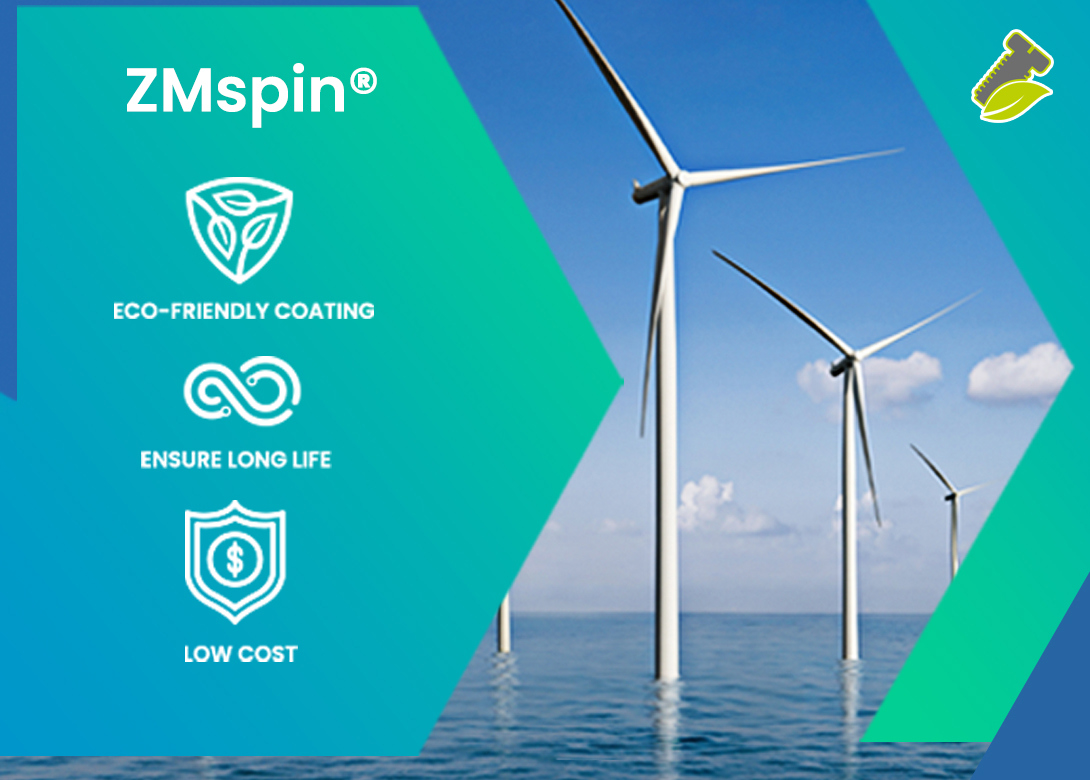
The ZMspin family of coatings allows the application of MgZnAl alloy coatings in the process of hot dip galvanising with centrifugation. This means that products such as bolts, nuts, washers or any other fasteners can obtain the highest level of corrosion resistance. This article outlines the technological process, tests as well as application examples for ZMspin.
Corrosion protection coatings based on an alloy of magnesium, zinc and aluminium have found a wide range of applications, especially in the automotive industry, due to the many advantages compared to conventional hot dip galvanising. They are also widely used in the construction industry, where structural elements are exposed to aggressive environmental conditions.
MgZnAl coatings, also known as ZM coatings, are mainly applied by plate manufacturers as a continuous hot dip galvanising process. Steel products with Magnelis, Zagnelis protection are characterised by significantly improved corrosion resistance, reduced thickness and increased flexibility of the coating in comparison to the classic hot dip galvanisation and at the same time better parameters required in the further processing of metal sheets to the finished product.
Technological process
The technological process used in the ZMspin process does not use acid, the use of which in surface preparation may pose a risk of surface hydrogenation and thus lead to hydrogen embrittlement. This is also the same as the compliance of the ZMspin coating with DAST 021 or ASTM F519. Throughout the ZMspin coating galvanising process, a low bath temperature is used to further ensure the components subjected to the ZMspin zinc plating process are not at risk of hydrogen embrittlement.
The application process of the ZMspin coating is carried out using a robotic line, which allows to achieve high repeatability and, consequently, high-quality of the anti-corrosion coating.
Tests
Tests of the ZMspin coating on fasteners have confirmed many of its unique properties. Due to the almost complete absence of white corrosion, the ZMspin coating offers the possibility of salt chamber testing, in which the samples showed no corrosion foci after testing from 1,500h. Fasteners with ZMspin coating were also tested in the Kesternich test, where they allowed a positive result in 10 cycles. The process also generates less waste compared to the standard HDG process, making it better for the environment.
ZMspin applications
Magnesium-Zinc alloy coatings are widely used on various types of sheet in the construction sector. When applied on fasteners, the Zmspin coating is the ideal complement to the protection of steel structures. Thanks to its properties, potential damage to the anti-corrosion coating during assembly is reduced to a minimum. Zmspin can be successfully used in applications requiring DUPLEX coatings.
These coatings can also be used in offshore wind energy applications. The owners and developers of offshore wind farms are currently facing the challenge of ensuring their farms have a life expectancy of 40 years. Another challenge is to reduce the maintenance costs of steel structures associated with the need for regular painting. ZMspin is the answer to these challenges and, thanks to its properties, is suitable for use in aggressive marine environments. ZMspin allows to obtain the corrosion class C3, while with the use of additional sealers applied after the ZMspin galvanising process, it is possible to obtain the highest class C5M.
Finally, the advantages of MgAlZn coatings have been known for many years in the automotive industry, in particular due to the high workability of MgAlZn coated sheets in presses. Sheet metal, which was protected with a classic zinc coating, caused many problems in processing, during which the pressed parts tended to crack. Another advantage of MgAlZn coatings appreciated by the automotive industry is the lower thickness of the coating, which results in increased susceptibility to processing such as welding or sealing. Zmspin coating applied on fasteners allows to unify anti-corrosion protection used for automotive components, thus constituting an alternative for flake coatings.
Finally, the advantages of MgAlZn coatings have been known for many years in the automotive industry, in particular due to the high workability of MgAlZn coated sheets in presses. Sheet metal, which was protected with a classic zinc coating, caused many problems in processing, during which the pressed parts tended to crack. Another advantage of MgAlZn coatings appreciated by the automotive industry is the lower thickness of the coating, which results in increased susceptibility to processing such as welding or sealing. Zmspin coating applied on fasteners allows to unify anti-corrosion protection used for automotive components, thus constituting an alternative for flake coatings.
zmspin.com

Having spent a decade in the fastener industry experiencing every facet – from steel mills, fastener manufacturers, wholesalers, distributors, as well as machinery builders and plating + coating companies, Claire has developed an in-depth knowledge of all things fasteners.
Alongside visiting numerous companies, exhibitions and conferences around the world, Claire has also interviewed high profile figures – focusing on key topics impacting the sector and making sure readers stay up to date with the latest developments within the industry.
Don't have an account? Sign Up
Signing up to FastFixTechnology.com enables you to manage your account details.